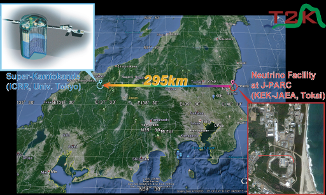![]() Accelerator neutrinos are recovering their lead
Accelerator neutrinos are recovering their lead

Fig:Overview of the T2K experiment in Japan. Image credit: T2K collaboration.
On July 19th 2013, the international T2K collaboration proudly announced definitive observation of muon neutrino to electron neutrino transformation. “This T2K observation is the first of its kind”, stated the collaboration in a press release, underlying that the probability for random statistical fluctuations to produce this result was less than on in a trillion.
In order to get to this result, the T2K experiment used data collected from the world’s largest underground neutrino detector, Super-Kamiokande, located in Japan. A muon neutrino beam was produced in the Japan Proton Accelerator Research Complex (J-PARC) and sent 295 km away to Super-Kamiokande, where its composition was studied and compared with the initial one.
Observation of this new type of neutrino oscillation opens the way to new studies - only possible with accelerator neutrinos - of charge-parity (CP) violation, which provides a distinction in physical processes involving matter and antimatter. CP violation in neutrinos in the very early universe might explain one of the most profound mysteries in science: the domination of matter over antimatter in our universe.
The T2K experiment is operated by an international collaboration, gathering over 400 physicists from 59 institutions in 11 countries.
